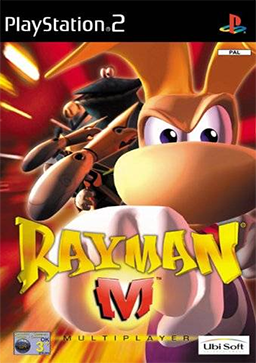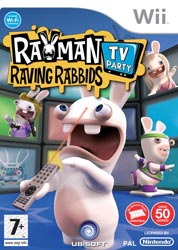
Rayman M, known in North America as Rayman Arena is a party video game developed and published by Ubisoft. A spin-off of the Rayman series, it features two modes, racing and battle, in which players take control of one of eighteen characters from the Rayman series. The game retains many elements from the 1999 platform game Rayman 2: The Great Escape such as the game's control system.

WarioWare: Smooth Moves is a party video game developed by Nintendo SPD and Intelligent Systems. The game was published by Nintendo for its Wii video game system in Japan in December 2006, and in Europe, North America, and Australia in January 2007. It is the fifth game in the WarioWare series of games, and the only game in the series to be physically released for the Wii. Like its predecessors, WarioWare: Smooth Moves is built around a collection of microgames that last about five seconds each, and which require that the player hold the Wii Remote in specific positions. The game offers the microgames to the player in rapid succession, by first instructing the player to hold the Wii Remote in a specific manner, and then showing them the microgame. The microgames are divided into several stages, each of which loosely connects the microgames with the help of a story. Additionally, this was the first spin-off Mario game to be released for the console.
Rayman is a franchise of platform video games, created by video game designer Michel Ancel for Ubisoft. Since the release of the original Rayman game in 1995, the series has produced a total of 45 games across multiple platforms.

Rabbids, also known as Raving Rabbids, is a multimedia franchise developed and published by Ubisoft. It originated as a spin-off video game from the Rayman video game series, 2006's Rayman Raving Rabbids. Rabbids is centered on a titular fictional species of mischievous rabbit-like creatures, who speak gibberish and scream wildly whenever they experience an adrenaline rush. Most video games from the franchise are of the party video game genre, though other genres have been explored as well.

Rayman Raving Rabbids is a 2006 platform game developed and published by Ubisoft for the Game Boy Advance and Nintendo DS. It was the handheld version of the 2006 party game Rayman Raving Rabbids.

Uno is a video game based on the card game of the same name. It has been released for a number of platforms. The Xbox 360 version by Carbonated Games and Microsoft Game Studios was released on May 9, 2006, as a digital download via Xbox Live Arcade. A version for iPhone OS and iPod devices was released in 2008 by Gameloft. Gameloft released the PlayStation 3 version on October 1, 2009, and also released a version for WiiWare, Nintendo DSi via DSiWare, and PlayStation Portable. An updated version developed by Ubisoft Chengdu and published by Ubisoft was released for the PlayStation 4 and Xbox One in August 2016, Microsoft Windows in December 2016 and for the Nintendo Switch in November 2017.

Rayman Raving Rabbids 2 is a party video game developed and published by Ubisoft. The sequel to Rayman Raving Rabbids and the second installment of the Raving Rabbids spin-off franchise, it was released for the Wii and Nintendo DS platforms worldwide in 2007. It follows the Rabbids' attempt to invade Earth, with their headquarters set up near a local shopping mall. Players have the option to play as a Rabbid or as Rayman, who has disguised himself as a Rabbid to infiltrate their plans. This is the first Rayman game to have an E10+ rating by the ESRB, a greater emphasis on simultaneous multiplayer gameplay compared to the original game, and online leaderboards. It was followed by Rayman Raving Rabbids: TV Party in 2008.

Rayman Raving Rabbids: TV Party is a party video game developed and published by Ubisoft in 2008 and is the third and final installment in the original Rayman Raving Rabbids' trilogy.

Rayman is the title character and main protagonist of the Ubisoft's Rayman series developed by Ubisoft Montpellier. He debuted in 1995 platform game Rayman and is a player character in all the games of the series. He is an anthropomorphic limbless protagonist dressed with a red neckerchief and white gloves with the ability to use his hair as helicopter blades and punch at a distance. He was created by his mother Betilla the Nymph as a hero.

Rabbids Go Home is an action-adventure video game developed and published by Ubisoft for the Wii and Nintendo DS. The game was released in North America on November 1, 2009, in Australia on November 5, 2009, and in Europe on November 6, 2009. A modified, shorter version of the game was ported to Microsoft Windows and released in Russia and Poland.

Just Dance is a 2009 music rhythm game developed by Ubisoft Paris and published by Ubisoft as the first main installment of the Just Dance series. The game was released exclusively for the Wii on November 17, 2009, in North America, November 26, 2009, in Australia, and November 27, 2009, in Europe.

Academy of Champions: Soccer is a soccer video game developed by Ubisoft Vancouver and published by Ubisoft for the Wii.

Raving Rabbids: Travel in Time is a party video game developed and published by Ubisoft for the Wii. It was released in North America on November 21, 2010, in Europe on November 26, 2010, in Australia on November 25, 2010 and in Japan on January 27, 2011. It is the fifth installment in the Rabbids series and, unlike the previous entry, Rabbids Go Home, it returns to the party game genre.

Raving Rabbids: Alive & Kicking known as simply Rabbids: Alive & Kicking, and as Rabbids: Fuori di schermo in Italy, is a Xbox Kinect party video game developed by Ubisoft Paris and Ubisoft Milan and published on December 26, 2011 in Australia, February 10, 2012 in Europe and March 20, 2012 in North America for the Xbox 360. This is the sixth game from the Rabbids games franchise and it is the first Rabbids game not released on the Nintendo Wii. The game was exclusively developed for the Kinect and consists of mini-games with up to 4 players.

Rayman Legends is a platform video game developed by Ubisoft Montpellier and published by Ubisoft. It is the fifth main title in the Rayman series and the direct sequel to the 2011 game Rayman Origins. The game was released for Microsoft Windows, PlayStation 3, Xbox 360, Wii U, and PlayStation Vita platforms in August and September 2013. PlayStation 4 and Xbox One versions were released in February 2014, with a Stadia version released in November 2021. A Nintendo Switch port, titled Rayman Legends Definitive Edition, was released in North America, Europe and Australia on September 12, 2017.

ZombiU is a first-person survival horror video game developed by Ubisoft Montpellier and published by Ubisoft. It was released for the Wii U as one of its launch games in November 2012. In the game, the player assumes control of a human survivor amid a 2012 zombie apocalypse. Featuring a permadeath system, it uses the Wii U GamePad extensively to scan the environment and maintain the survivor's inventory. The game was released under the name Zombi for PlayStation 4, Windows, and Xbox One in 2015. The port, handled by Straight Right, adds new melee weapons and removes the multiplayer feature.

Just Dance 2018 is a 2017 dance rhythm game developed and published by Ubisoft. It was unveiled on June 12, 2017, during its E3 press conference as the ninth main installment of the series, and was released in October 2017 for PlayStation 3, PlayStation 4, Xbox 360, Xbox One, Wii, Wii U, and Nintendo Switch. This was the last Just Dance game to be released on the PlayStation 3 console, and by extension, the final PlayStation 3 video game to be published by Ubisoft.

Cake Bash is a party video game developed by High Tea Frog and published by Coatsink. The game was released for Microsoft Windows, PlayStation 4, Xbox One, and Google Stadia on October 15, 2020, later releasing on November 19 for the Nintendo Switch. In the game, players control cakes competing against each other in order to be chosen by a customer.

















